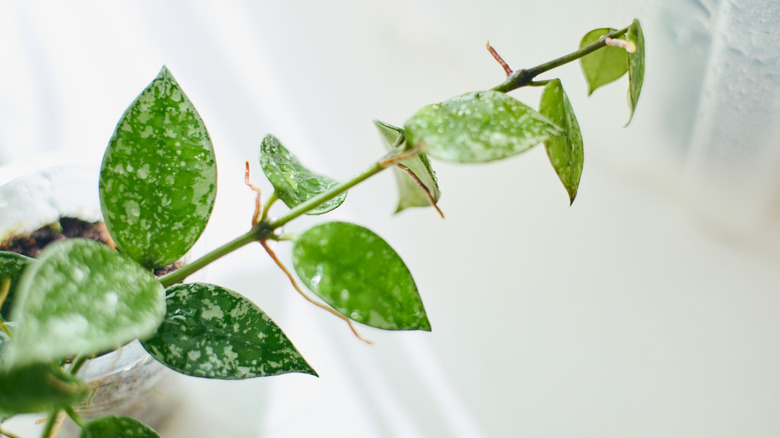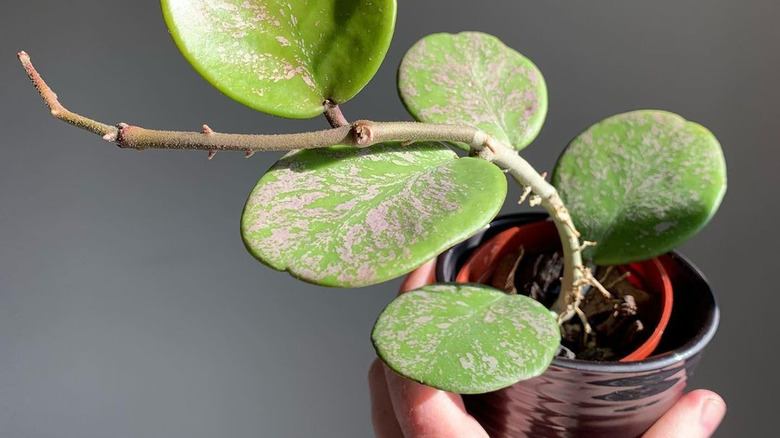The Best Methods For Propagating A Hoya Plant
Once you learn how to grow and care for a hoya plant, it's easy to fall in love. With patience and proper tending, these popular houseplants will reward you with beautiful, fragrant flowers and an infinite supply of new plants, thanks to the wonders of propagation. As with all things hoya, propagation requires the right technique to get good results.
Hoyas are also called "wax plants" because of their thick, glossy leaves and waxy flowers. With a natural range across Southeast Asia and Australia, they come in a ton of different colors and shapes, which is part of why they're so beloved as houseplants. Some of the most popular hoya species are Hoya carnosa, Hoya kerrii, and Hoya linearis.
Despite visual differences, hoya varieties tend to have some traits in common: most are climbers, they're slow-growing, and it requires patience to see them bloom. Collecting hoyas can become pricey, but you can get more plants for free by propagating the ones you already have. There are a few different methods, all of which start with taking a cutting from a healthy plant. The best time to propagate a hoya is in the spring or early summer; this is the natural growth season of a hoya, so the cutting will have a better chance at getting established.
Hoya propagation 101
First, choose the healthiest hoya that you've got to use for cuttings, preferably a mature one that will be less likely to suffer from losing a stem. Hoyas are one of those houseplants with abnormally long lives, and you can take multiple cuttings from one plant. But try not to remove more than 40% of a mature plant's foliage at once so you can enjoy it for years to come.
To take a cutting, snip a stem just below a leaf node with sharp, sterile scissors. The cutting should be around four to six inches long and have between two and six leaves. Remove the bottom sets of leaves, keeping two or three healthy leaves at the top of the cutting. Alternatively, you can take a "softwood cutting," or the new green growth at the end of a stem. Choose a section of softwood with nodes that roots can grow from. With hoyas, you can use leaves as cuttings, but the leaf will only grow roots — it won't grow into a full, new plant like a stem or softwood cutting will. Whenever you cut from a hoya, take care to protect your hands from the sap, which can cause skin irritation.
Next, put the cutting in a soil mix or water. Place it in a bright area at room temperature and wait for it to develop roots, which usually takes a few weeks. If you like, you can speed up the process by adding a rooting hormone to the cutting.
Water vs. soil propagation, and other options
Any soil or potting mix can work for hoya propagation. However, one that holds more water is more likely to be successful because hoya cuttings need to remain moist for roots to grow. One recipe that works well is three parts perlite, three parts coco-peat, and one part vermiculite. Some people have more luck propagating hoyas in sphagnum moss, which stores water very well. Propagating in water is also an easy way to ensure that the cutting remains wet.
If you propagate in soil, potting mix, or moss, keep it consistently moist. With soil or potting mix, you will also have to gently lift the cutting to check on root growth from time to time. Water propagation allows you to easily track root development. Just make sure the lowest nodes remain in contact with the water and change the water once a week. Once the roots are about one-third of the size of the cutting, it's time to repot your hoya plant in its new home.
Another effective method for propagating hoyas is layering: bending a shoot directly into a new container of potting mix without cutting it. With this method, you peg the shoot into place and wait for it to develop roots in the new container, which minimizes stress on the original plant. Remove the leaves on the shoot that are touching the potting mix, and keep the mix moist. Once the shoot forms roots, it can be cut from the original plant. You can also layer multiple shoots into the same container to increase your odds that one will take root.


